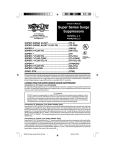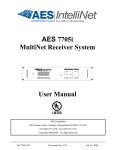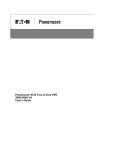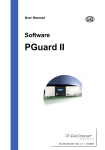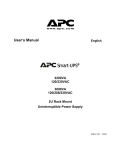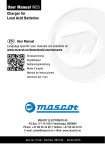Download APC Back-UPS Pro 280/420/650 User`s Manual
Transcript
APC Back-UPS Pro® 280/420/650 User’s Manual 990-2037B Revision 3 12/97 Installation and Initial Start-Up To obtain warranty coverage, please fill out and return the warranty registration card now. Check the Site Wiring Fault Indicator Location: Top right corner of UPS back panel. Inspection Inspect the UPS upon receipt. Notify the carrier and dealer if there is damage. The packaging is recyclable; save it for reuse or dispose of it properly. Caution: If the site wiring fault indicator lights, get a qualified electrician to correct the building wiring. Placement Connect the Loads Plug the loads into the output connectors on the rear of the UPS. To use the UPS as a master “On/Off” switch, make sure that all of the loads are switched “On”. Install the UPS in a protected area that is free of excessive dust and has adequate air flow. Do not operate the UPS where the temperature and humidity is outside the specified limits. Warning: Changes or modifications to this unit not expressly approved by the party responsible for compliance could void the warranty. Connect to Utility Caution: Do not connect a laser printer to the Battery Backup Outlets. Cord Straps: Straps are provided to keep cords from tangling and taking up too much space. Battery Backup Outlets: These UPS outlets provide battery power and surge protection to equipment when utility voltage is outside acceptable limits. Data sensitive equipment such as a computer, monitor, or external drive are connected to these outlets. Surge Protected Outlets: These outlets are for equipment that need surge protection but do not need power during a utility outage (like an inkjet printer or scanner). Block Safe Outlets: (420/650): Corded sockets are provided which accept “block type” plugs without covering other outlets. Some printers and external disk drives have block type plugs that look similar to the one below. Connect Telephone / Network Surge Suppression (Optional) Connect a single line telephone or a 10Base-T/ 100Base-Tx network cable into the RJ-45/RJ-11 telephone/network surge protection “IN” jack on the back of the UPS. Connect from the “OUT” jack with telephone cable (supplied) or network cabling (not supplied) to a fax modem or network port. Connect Computer Interface Port (Optional) PowerChute® plus power management software is included with this UPS. Connect the supplied interface cable to the 9-pin computer interface port on the back panel of the UPS. Connect to the computer. See software documentation for installation instructions. Charge the battery The UPS charges its battery whenever it is connected to utility power. The battery will charge fully during the first 4 hours of normal operation. Do not expect full runtime during this initial charge period. Operating Instructions Switch “On” — Switch “Off” With the UPS plugged in, press and release the On/Off/Test button to supply power to the loads. The UPS loads are immediately powered while the UPS performs a self-test. Press and release the button again to turn “Off” power to the loads. It may be convenient to use the UPS as a master “On/Off” switch for the protected equipment. Note: Surge protected outlets are powered whenever the UPS has utility power. The on-line LED illuminates when the UPS is supplying utility power to the battery backup loads. Self-test The UPS performs a self-test automatically when turned “On”, and every two weeks thereafter (by default). Automatic self-test eliminates the need for periodic manual self-tests. During the self-test, the UPS briefly operates the loads on-battery. If the UPS passes the self-test, it returns to on-line operation. If the UPS fails the self-test it immediately returns to on-line operation and lights the replace battery LED. The loads are not affected by a failed test. Recharge the battery overnight and perform the self-test again. If the replace battery LED is still "On”, replace the battery using the Replacing the Battery procedure. On-Battery During on-battery operation, the onbattery LED illuminates and the UPS sounds an audible alarm consisting of 4 beeps every 30 seconds. The alarm stops when the UPS returns to on-line operation. Low Battery When the UPS is operating on-battery and the energy reserve of the battery runs low, the UPS beeps continuously until the UPS shuts down from battery exhaustion or returns to on-line operation. Overload When loads exceed the UPS’s capacity, the overload LED illuminates and the UPS emits a sustained tone. The alarm remains “On” until the overload is removed. Disconnect nonessential load equipment from the battery backup outlets, to eliminate the overload. If the overload is severe, the input circuit breaker may trip (the resettable center plunger of the circuit breaker pops out), as well. Disconnect nonessential load equipment from the UPS to eliminate the overload and press the plunger back in to restart the UPS. If there is AC power and the circuit breaker does not trip during overload, the loads are still powered. If the circuit breaker trips or the UPS attempts to transfer to battery, the loads’ power will be shut “Off”. Turn the UPS “Off” then back “On” to repower the loads. Replace Battery If the battery fails a self-test, the UPS emits short beeps for one minute and the replace battery LED illuminates. The UPS repeats the alarm every five hours. Perform the self-test procedure to confirm replace battery conditions. The alarm stops when the battery passes the self-test. Shutdown Mode If there is no power, the host connected to the computer interface port can command the UPS to shut down. This is normally done to preserve battery capacity after a controlled shutdown of the protected system. In shutdown mode the UPS stops supplying power to the load. The online and overload LED indicators flash alternately or, if the UPS has shutdown due to a low battery, the UPS will beep once every 4 seconds for approximately 16 seconds. When line power is restored, the UPS will return to on-line operation. Cold Start Note: Cold start is not a normal operating condition. When the UPS is “Off” and there is no utility power, it is possible to cold start the UPS to power the loads from the UPS’s battery. • Press and hold the On/Off/Test button until the UPS begins beeping. • Release the On/Off/Test button during the beeping to start the UPS. APC, Back-UPS Pro, and PowerChute are registered trademarks of American Power Conversion. Storage Storage conditions Extended storage Store the UPS covered and upright in a cool, dry location, with its battery fully charged. Before storing, charge the UPS for at least 4 hours. At -15 to +30 °C (+5 to +86 °F), charge the UPS’s battery every 6 months At +30 to +45 °C (+86 to +113 °F), charge the UPS’s battery every 3 months. Replacing the Battery This UPS has an easy to replace hot-swappable battery. 3. Disconnect the two wires connecting the battery to the UPS. Loosen the wires by wiggling them while pulling straight back from the battery connector. Note: Please read the cautions in the APC Safety Guide. Replacement Batteries See your dealer or call the number in this manual for information on replacement battery kits. For 280 and 420 models, order RBC 2. For 650 models, order RBC 4. 4. Connect the new battery in place of the old. Note: Small sparks at the battery connections are normal during connection. Battery Replacement Procedure Battery replacement is a safe procedure, isolated from electrical hazards. You may leave the UPS and loads “On” for the following procedure. 5. Place the new battery in the UPS. Use care to avoid pinching the wires. Note: Once the battery is disconnected, the loads are not protected from power outages. 6. Close the battery compartment door and replace the screws. 1. Lay the UPS on its left side. Remove the two screws holding on the battery door and open the door. 7. Dispose of the old battery properly at an appropriate recycling facility or return it to the supplier in the packing material for the new battery. See the new battery instructions for more information. Note: It may be necessary to pull the battery door slightly toward the front of the unit in order to open the door fully. 2. Gently pull out the battery by grasping the white tab. Service If the UPS requires service, please do Not return it to the dealer! Follow these steps: 1. Use the Troubleshooting section of the Quick Reference Guide to eliminate common problems. Troubleshooting Problem UPS will not turn “On”. Possible Cause On/Off/Test button not pushed. UPS input circuit breaker tripped. UPS will not turn “On” or “Off”. UPS operates on-battery even though normal line voltage is thought to exist. Computer interface problem. UPS's input circuit breaker tripped. UPS beeps occasionally. Normal UPS operation. UPS does not provide expected back up time. The UPS's battery is weak due to recent outage or is near the end of its service life. On-line and overload indicators are flashing alternately. The UPS was shutdown ® by PowerChute plus software. All indicators are flashing. Internal UPS fault. The UPS operates normally, but the site wiring fault indicator is lit. On-line and on-battery indicators only are flashing Building wiring error such as missing ground or hot to neutral wire reversal. Internal UPS fault. All indicators are “Off” and the UPS is not operating. The UPS is shutdown and the battery is discharged from an extended power outage. The replace battery light is illuminated. The overload light is illuminated or flashing Weak batteries. Replacement batteries not connected properly. The UPS is overloaded. Solution Press the On/Off/Test button to power the UPS and the loads. Reduce the load on the UPS by unplugging equipment and reset the circuit breaker by pressing the plunger back in. Disconnect the computer interface. If the UPS now works normally, check the interface cable and the attached computer. Reduce the load on the UPS by unplugging equipment and reset the circuit breaker by pushing the plunger back in. None. The UPS is protecting the load. Charge the battery. The UPS's batteries require recharging after an extended outage. Batteries age faster when put into service often and when operated at elevated temperatures. If the battery is near the end of its service life, consider replacing the battery even if the replace battery indicator is not yet lit. None. The UPS will restart automatically when utility power returns. Do not attempt to use the UPS. Turn the UPS “Off” and have it serviced immediately. Have a qualified electrician correct the building wiring. Do not attempt to use the UPS. Turn the UPS “Off” and have it serviced immediately. None. The UPS will return to normal operation when the power is restored and the battery has a sufficient charge. Allow the batteries to recharge for at least 4 hours. If the problem persists after recharging, replace the batteries. Confirm the battery connections. Reduce the load on the UPS by unplugging equipment. 2. Verify that no circuit breakers are tripped. A tripped circuit breaker is the most common UPS problem! 3. If the problem persists, call customer service or visit the APC Internet Website (www.apcc.com). • Note the model number of the UPS, the serial number, and the date purchased. A technician will ask you to describe the problem and try to solve it over the phone, if possible. If this is not possible the technician will issue a Return Merchandise Authorization Number (RMA#). • If the UPS is under warranty, repairs are free. If not, there is a repair charge. 4. Pack the UPS in its original packaging. If the original packing is not available, ask customer service about obtaining a new set. • Pack the UPS properly to avoid damage in transit. Never use Styrofoam™ beads for packaging. Damage sustained in transit is not covered under warranty. • Include a letter with your name, RMA#, address, copy of the sales receipt, description of the trouble, your daytime phone number, and a check (if necessary). 5. Mark the RMA# on the outside of the package . 6. Return the UPS by insured, prepaid carrier to the address given to you by Customer Service. APC Contact Information Internet USA/Canada ………….. 1-800-800-4272 Mexico ………………….. 292-0253 / 292-0255 Brazil ……………………. 0800-12-72-21 Worldwide ……………… 1-401-789-5735 http://www.apcc.com E-Mail [email protected] Specifications 280 VA Acceptable input voltage Input voltage (on-line operation)* Output voltage * Input Over Current Protection Frequency limits (on-line operation) Transfer time Maximum load On-battery output voltage On-battery frequency On-battery waveshape Output Over Current Protection Battery type Typical battery life Typical recharge time Operating temperature Storage temperature Operating / storage relative humidity Operating elevation Storage elevation Audible noise at 1 m (3 ft) Size (H x W x D) Weight - net (shipping) For Computer Interface Port Specifications, see the APC Website. 420 VA 650 VA 0 - 160 VAC 81-143 VAC 106-127 VAC Resettable circuit breaker 47 - 63 Hz (autosensing) 4 ms typical, blackout response time 280 VA 420 VA 650 VA 180 W 260 W 410 W 115 VAC 50 or 60 Hz, ±0.1 Hz; unless synchronized to utility during brownout Stepped sine-wave Overcurrent and short-circuit protected, latching shutdown on overload Spill proof, maintenance free, sealed lead-acid 3 to 6 years, depending on number of discharge cycles and ambient temperature 2 to 5 hours from total discharge 0 to +40 °C (+32 to +104 °F) -15 to +45 °C (+5 to +113 °F) 0 to 95%, non-condensing 0 to +3,000 m (0 to +10,000 ft) 0 to +15,000 m (0 to +50,000 ft) <45 dBA 15 x 8.6 x 33.8 cm 16.8 x 11.9 x 36.8 cm (5.9 x 3.4 x 13.3 in.) (6.6 x 4.7 x 14.5 in.) 7.5 (9.3) kg 16.6 (20.4) lb. 10.0 (10.9) kg 22.0 (24.0) lb. 12.3 (13.2) kg 27.0 (29.0) lb. Listing, Certifications and Unlisted UL 1778, UL 497A, CSA 107.1, FCC part 15 Components EMI certification FCC/DOC Class B certified Electromagnetic immunity IEC 801-4 level IV, 801-5 level III * User-adjustable through PowerChute® plus (see software documentation) Mouser Electronics Authorized Distributor Click to View Pricing, Inventory, Delivery & Lifecycle Information: APC: BP280S




